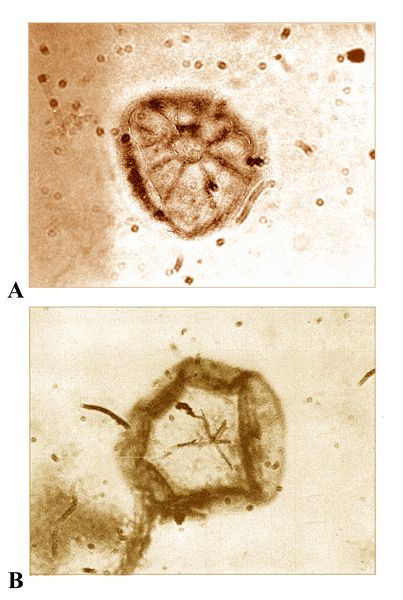Athena Review Image Archive ™
Kakabekia barghoorniana

Kakabekia barghoorniana (after Siegal and Siegal 1970, fig.3)
Kakabekia barghoorniana
is a present day anaerobic bacteria, originally discovered in 1964 by
biologist S.M. Siegal with soil samples from Wales, and subsequenly
found throughout the world in soils of Alaska, Iceland,
Nepal,
Mexico, Columbia, Equador, and Hawaii. It is named Kakabekia for Kakabeka Falls in Ontario, and barghooriana for Elso Barghoorn who discovered similar Early Precambrian bacterial forms in the Gunflint Chert of Canada.
When Siegal was experimenting with
ammonia-tolerant organisms at the University of Hawaii, as part of a project to describe possible
lifeforms surviving in extreme conditions, he came across a tiny,
umbrella-shaped form in soil samples from Wales. When he saw the 1965
Barghoorn and Tyler paper on the Gunflint Chert fossils, he recognized
the same form in their Kakabekia umbellata. After more research to
confirm the similarities, based on a number of examples studied, Siegal
and his colleagues announced the new species Kakabekia barghoorniana, as a living fossil related to, and closely resembling the
two-billion-year-old Kakabekia umbellata (Siegal et al. 1967).
Lacking a nucleus, K. barghooriana is also a prokaryote. It has to live in or obtain ammonia, thus deriving its energy from ammonia, and has no storage of lipids or polysaccharides. It is anaerobic, but can tolerate oxygen. The stalk and basal bulb of the complete umbellate structure formed part of the spore-based reproductive apparatus. In parallel with the fossil forms, the live organism also showed a number of variant forms of both mantle and main stipes, sometimes lacking the latter. The mantle usually had 6-8 radial spokes or branches, which meet in a ring-shaped central feature
In the figure, Kakabekia barghoornia
shows two variants of its mantle or parachute-like form: A) a fully
developed radial system with a well-defined central feature; B) an
incomplete radial system, with the mantle margin folded over; part of
the main stipes or stem is visible below (from Siegal and Siegal 1970,
fig.3)
References:
Siegal,
B.Z. and S.M. Siegal 1970. Biology of the Precambrian genus
Kakabekia: New Observations on Living Kakabekia barghoorniana. Proceedings of the National Academy of Sciences of the USA 67(2), pp. 1005-1010.
Siegal, S.M., K. Roberts, H. Nathan, and O. Daly 1967. Living Relative of the Microfossil Kakabekia. Science 156, pp. 1231-1234.
:
Copyright © 1996-2020 Rust Family Foundation (All Rights Reserved).